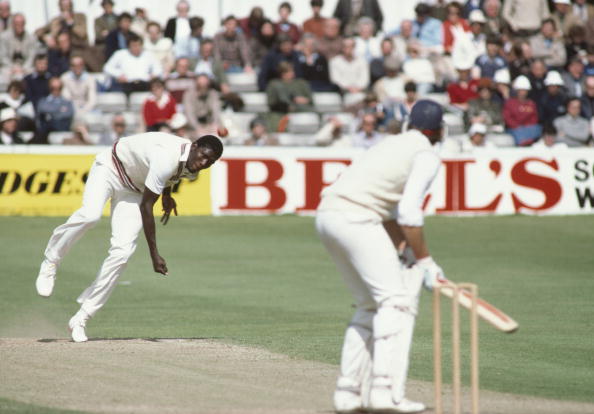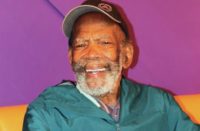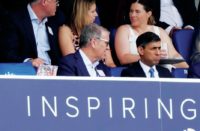So who would be the greatest club side the game has seen? Derek Pringle believes the Barbados boys of 1979/80 are up there with a shout…
Accolades for Barbados and its cricketers have been pouring in as the island celebrates 50 years of independence from Britain. But for all the stellar players this tiny place has produced throughout cricket history like Garry Sobers, Clyde Walcott, Frank Worrell and Malcolm Marshall, it retains special meaning for me as the birthplace of my favourite cricketer – Joel ‘Big Bird’ Garner.
Garner, or Bird as most still know him, was a gigantic 6ft 8ins tall pace bowler, with a spinner’s precision control of the ball. Batsmen facing him used to say two things: what a fearsome, off-putting sight he was charging in to bowl; and that he had the ball on a string so probing was his accuracy.
Nobody, not even Waqar Younis or Wasim Akram, could summon a yorker at will quite like Bird. You’d think that with a reputation for bowling them, batsmen would be on red alert for his toe-crusher, but he was brilliant at setting them up for a fall.
My first encounter was in 1981 when Essex played Somerset at Taunton in the County Championship. “Watch out for his yorker,” was the collective advice as I headed out to bat. What they never mentioned were the series of jarring lifters he sent down that drove you ever further back before, with extra effort and therefore a yard quicker as a result, he slipped you the yorker, with predictable stump-splaying effect.
Those yorkers were mostly for suckers and tailenders. Once Bird rated you, he would rarely bowl them, opting instead to wear you down with dot balls. He hated giving away runs so mostly he would plug away outside off-stump, with the odd leather sniffer and blockhole ball just to keep you honest. He was, after all, the West Indies’ stock bowler.
Despite that, his international record is phenomenal. In 58 Tests for the West Indies he took 258 wickets at 20.97 apiece, one of the lowest averages ever for bowlers taking more than 100 Test wickets. What is more, he achieved those figures in bowling attacks comprising, variously, Marshall, Andy Roberts, Michael Holding and Colin Croft, where competition for wickets was red hot.
There was no slacking in limited-overs cricket either, where he took 146 wickets at 18.8 with an economy rate of 3.09 runs an over. I know the one-day game has changed markedly in the last decade, but I can’t see him getting collared all that often even now, such was his iron control of line, length and emotion.
For a mean bowler, in both senses of the word, he had the broadest of grins and a near unquenchable thirst for rum and fun. Like many of his fellow Bajans, Bird is a devotedly social beast liking nothing more than to regale friends with drink in hand.
Once, in Taunton, on the way to a benefit function, he managed to unlock his front door, open a bottle of Mount Gay and fill three glasses all in one slick motion. It led Graham Gooch, the other person there that evening, to ask him if he found captaining Barbados that easy.
“Man, it don’t vex me too much,” said Bird, only half joking. “Me and Macco (Marshall) take the new ball and get the top five out. Then I let a couple of the others have a bowl and they get the next three. Then me and Macco come on again and blow away the tail. We then have a bat. Gordon (Greenidge) and Desi (Desmond Haynes) smash it until we get a 100 lead. Then we bowl them out again.”
That side he captained won the Shell Shield in 1985/86, but it was the Barbados team of 1979/80, which also won the Shield, that was arguably the greatest club side in history.
Instead of facing a formidable pace quartet, teams turning up had to contend with Garner, Marshall, Sylvester Clarke and Wayne Daniel, an experience akin to meeting the four horsemen of the apocalypse on a bad day. As a result, few teams were able to withstand them let alone give them a close game.
They also had, in Albert Padmore, a canny spinner for when pace was not the answer, while Greenidge and Haynes were the best and most aggressive openers in world cricket. They also had Collis King as well as the estimable Thelston Payne and Emmerson Trotman, none of them slouches with a bat.
It is idle speculation, but you wonder if any team in history could have beaten them? The Essex side of 1986 with Gooch, Allan Border, Keith Fletcher, John Lever, Neil Foster, John Childs and yours truly, which won the Championship, might have given them a close game, but Barbados had sustained pace to hand when such firepower ruled the game. But then Gooch and Border were the two batsmen Marshall rated most highly when bowling for the West Indies.
Then there was the County Championship-winning Middlesex side of 1980, the same era as that incredible Barbados side. Led by Mike Brearley, they had Vintcent van der Bijl, Mike Selvey and Daniel (somehow to be shared between the two teams) to bowl seam and swing with Phil Edmonds and John Emburey to bowl spin. But if that was an extremely talented and well-balanced attack, Middlesex’s batting, with Mike Gatting, Clive Radley and Graham Barlow its mainstays, perhaps lacked that bit of class to take on Barbados’ pace battery.
What about the Surrey sides of the 1950s, or Yorkshire in the mid-1960s, both multiple winners of the County Championship, or the West Australian side that had Dennis Lillee and Terry Alderman in it? Those first two sides had brilliant batsmen and bowlers to exploit or cope with uncovered pitches, but you wonder how they would cope with Garner and Co on a fast, bouncy pitch at the Kensington Oval in Bridgetown?
Equally, though, how would Greenidge and Haynes cope on a sticky dog at Headingley or the Oval, with Fred Trueman and Ray Illingworth, or Jim Laker and Tony Lock, getting the ball to bite and misbehave?
One day, the boffins will come up with an algorithm to predict the greatest cricket club side in history and settle the debate, at least from the data.
Until then, my judgment says that Barbados team of 1979/80 was the greatest, a team that should have been sponsored by Carlsberg and one which remains a fitting testament to that great little island in the Caribbean Sea.
This piece originally featured in The Cricket Paper, December 9 2016
Subscribe to the digital edition of The Cricket Paper here















